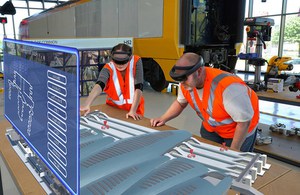Staff at a new HS2 and Crossrail train station will undergo an AR training programme to prepare them for life at what is expected to be one of London’s busiest interchanges.
Old Oak Common station in west London, which is expected to serve around 275,000 passengers every day when it opens in 2026, will be created in AR so that staff can familiarize themselves with its inner workings.
“The challenge is that Old Oak Common station hasn’t been built yet. So to train the station’s entirely new workforce with the skills and knowledge they will need we must innovate,” said HS2 Ltd’s Stations Director, Mike Luddy.
“Through this project, which is supported by Innovate UK and the DfT, we’re harnessing the power of digital technology to build Old Oak Common in augmented reality.”
The AR training programme is geared towards customer service and helping staff become more familiar with maintenance and safety protocols. It is also hoped staff who have completed the course can relay any design issues that can be tackled during the building phase in order to avoid costly changes once the station is opened to the public.
The project is being conducted in collaboration with the National College for High Speed Rail, innovation management consultancy Inventya and immersive technology firm PAULEY.
“We’re only starting to harness the power of augmented reality. Few people really get what it is and what it can do,” said Philip Pauley, founder and Managing Director of PAULEY.
“The way you might want to think about it is like that famous Star Wars scene where R2-D2 projects a 3D image of Princess Leia. That’s what AR is, except for now it’s with the addition of a high-tech visor through which to see it.
“The technology we’re bringing to HS2 enables the wearer to see Old Oak Common station in minute detail. It unlocks huge opportunities to explore, test and refine a digital replica of the station years before the passengers arrive.”

